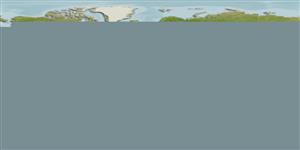>
Gobiesociformes (Clingfishes) >
Gobiesocidae (Clingfishes and singleslits) > Haplocylicinae
Etymology: Haplocylix: Greek, haploos = single + Greek, kylix, -ikos = glass, cup (Ref. 45335).
More on author: Forster.
Environment: milieu / climate zone / depth range / distribution range
Ecologia
marinhas demersal; intervalo de profundidade 0 - 12 m (Ref. 9003). Temperate
Southwest Pacific: endemic to New Zealand.
Tamanho / Peso / Idade
Maturity: Lm ? range ? - ? cm
Max length : 15.0 cm TL macho/indeterminado; (Ref. 9003); idade máx. registrada: 6 anos (Ref. 9003)
Descrição suscinta
Chaves de identificação | Morfologia | Morfometria
Espinhos dorsais (total) : 0; Raios dorsais (total) : 5 - 6; Espinhos anais: 0; Raios anais : 8 - 9. Color ranging from uniform olive green to golden brown or yellowish, sometimes lighter ventrally. Sometimes with darker streaks over the head and body or patches of white or pink. Distinguished from other clingfishes by its large size, broad spade-like body, and structure of sucking disc (absence of a fold of skin on the anterior margin of the rear portion).
Common in rock pools, larger individuals found in subtidal area. Usually attached to seaweeds (Cystophora, Macrocystis and Lessonia), sometimes on rocks and boulder in areas with dense seaweed. Remains motionless when the pool is disturbed.
Ciclo de vida ou comportamento de acasalamento
Maturities | Reprodução | Spawnings | Egg(s) | Fecundities | Larvas
Paulin, C. and C. Roberts, 1992. The rockpool fishes of New Zealand (Te ika aaria o Aotearoa). Museum of New Zealand (Te Papa Tongarewa). 177 p. (Ref. 9003)
Status na Lista Vermelha da UICN (Ref. 130435)
Ameaça para os humanos
Harmless
Uso pelos humanos
Ferramentas
Relatórios especiais
Baixar XML
Fontes da internet
Estimates based on models
Preferred temperature (Ref.
123201): 13.8 - 18.3, mean 16.4 °C (based on 100 cells).
Índice de diversidade filogenética (Ref.
82804): PD
50 = 1.0000 [Uniqueness, from 0.5 = low to 2.0 = high].
Bayesian length-weight: a=0.00427 (0.00210 - 0.00866), b=3.14 (2.95 - 3.33), in cm total length, based on LWR estimates for this species & (Sub)family-body (Ref.
93245).
Nível Trófico (Ref.
69278): 3.4 ±0.3 se; based on size and trophs of closest relatives
Resiliência (Ref.
120179): Baixo, tempo mínimo de duplicação da população 4,5 - 14 anos (Fec = 50).
Fishing Vulnerability (Ref.
59153): Low vulnerability (10 of 100).
Nutrients (Ref.
124155): Calcium = 76.1 [42.5, 172.8] mg/100g; Iron = 0.398 [0.227, 0.755] mg/100g; Protein = 17.1 [15.9, 18.3] %; Omega3 = 0.412 [0.204, 0.836] g/100g; Selenium = 7 [3, 17] μg/100g; VitaminA = 34.8 [8.6, 140.7] μg/100g; Zinc = 0.922 [0.611, 1.358] mg/100g (wet weight);
